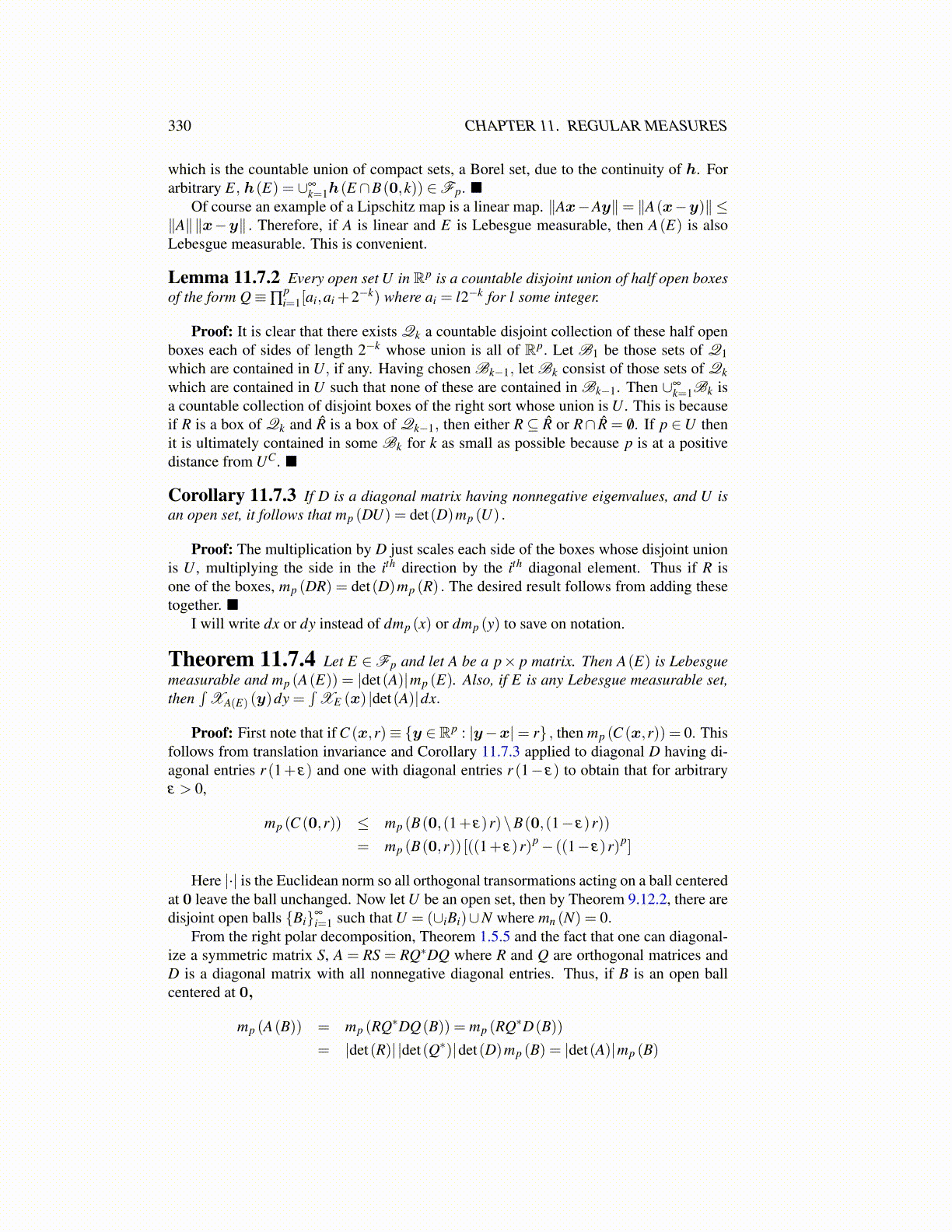
330 CHAPTER 11. REGULAR MEASURES
which is the countable union of compact sets, a Borel set, due to the continuity of h. Forarbitrary E, h(E) = ∪∞
k=1h(E ∩B(0,k)) ∈Fp. ■Of course an example of a Lipschitz map is a linear map. ∥Ax−Ay∥= ∥A(x−y)∥ ≤
∥A∥∥x−y∥ . Therefore, if A is linear and E is Lebesgue measurable, then A(E) is alsoLebesgue measurable. This is convenient.
Lemma 11.7.2 Every open set U in Rp is a countable disjoint union of half open boxesof the form Q≡∏
pi=1[ai,ai +2−k) where ai = l2−k for l some integer.
Proof: It is clear that there exists Qk a countable disjoint collection of these half openboxes each of sides of length 2−k whose union is all of Rp. Let B1 be those sets of Q1which are contained in U, if any. Having chosen Bk−1, let Bk consist of those sets of Qkwhich are contained in U such that none of these are contained in Bk−1. Then ∪∞
k=1Bk isa countable collection of disjoint boxes of the right sort whose union is U . This is becauseif R is a box of Qk and R̂ is a box of Qk−1, then either R ⊆ R̂ or R∩ R̂ = /0. If p ∈U thenit is ultimately contained in some Bk for k as small as possible because p is at a positivedistance from UC. ■
Corollary 11.7.3 If D is a diagonal matrix having nonnegative eigenvalues, and U isan open set, it follows that mp (DU) = det(D)mp (U) .
Proof: The multiplication by D just scales each side of the boxes whose disjoint unionis U , multiplying the side in the ith direction by the ith diagonal element. Thus if R isone of the boxes, mp (DR) = det(D)mp (R) . The desired result follows from adding thesetogether. ■
I will write dx or dy instead of dmp (x) or dmp (y) to save on notation.
Theorem 11.7.4 Let E ∈Fp and let A be a p× p matrix. Then A(E) is Lebesguemeasurable and mp (A(E)) = |det(A)|mp (E). Also, if E is any Lebesgue measurable set,then
∫XA(E) (y)dy =
∫XE (x) |det(A)|dx.
Proof: First note that if C (x,r)≡ {y ∈ Rp : |y−x|= r} , then mp (C (x,r)) = 0. Thisfollows from translation invariance and Corollary 11.7.3 applied to diagonal D having di-agonal entries r (1+ ε) and one with diagonal entries r (1− ε) to obtain that for arbitraryε > 0,
mp (C (0,r)) ≤ mp (B(0,(1+ ε)r)\B(0,(1− ε)r))
= mp (B(0,r)) [((1+ ε)r)p− ((1− ε)r)p]
Here |·| is the Euclidean norm so all orthogonal transormations acting on a ball centeredat 0 leave the ball unchanged. Now let U be an open set, then by Theorem 9.12.2, there aredisjoint open balls {Bi}∞
i=1 such that U = (∪iBi)∪N where mn (N) = 0.From the right polar decomposition, Theorem 1.5.5 and the fact that one can diagonal-
ize a symmetric matrix S, A = RS = RQ∗DQ where R and Q are orthogonal matrices andD is a diagonal matrix with all nonnegative diagonal entries. Thus, if B is an open ballcentered at 0,
mp (A(B)) = mp (RQ∗DQ(B)) = mp (RQ∗D(B))
= |det(R)| |det(Q∗)|det(D)mp (B) = |det(A)|mp (B)